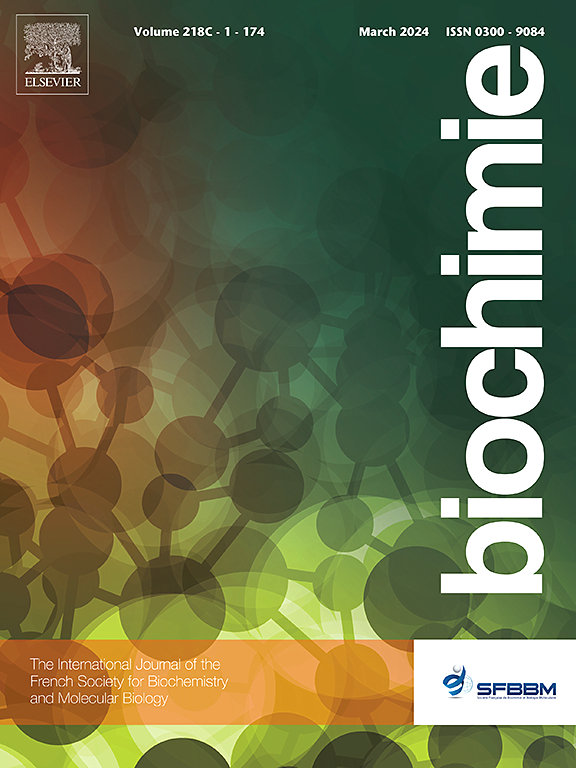揭示原生动物寄生虫唐氏利什曼原虫中橙皮甙诱导 LdTopI 介导的细胞死亡途径的机制。
IF 3.3
3区 生物学
Q2 BIOCHEMISTRY & MOLECULAR BIOLOGY
引用次数: 0
摘要
单细胞原生动物利什曼原虫(Leishmania donovani)是内脏利什曼病(VL)或卡拉扎病(Kala-azar)的病原体,这是一种被忽视的致命寄生虫病。内脏利什曼病的传统治疗方法包括使用具有毒性、高成本、疗效不一和耐药性增加等缺点的治疗药物。因此,迫切需要开发一种有效的寄生虫治疗方法。以前的报道表明,黄酮类化合物能抑制唐氏利什曼原虫 DNA 拓扑异构酶 I(LdTopILS)。因此,在本研究中,我们首次发现 HSP(黄酮类化合物的天然来源之一)是一种有效的天然抗利什曼病化合物,对 BALB/c 小鼠的疗效为 20 毫克/千克体重,在预孵育条件下 160 μM 时可抑制 LdTopILS 97% 的活性(竞争性)。它与游离酶结合,不允许其与底物 DNA 结合。此外,HSP 不会稳定 DNA-拓扑异构酶 I 可裂解复合物。因此,HSP 是一种催化拓扑异构酶 I 抑制剂,它通过与酶大亚基的 Lys269 和 Thr411 结合来抑制拓扑异构酶 I 的全部活性。另一方面,HSP 通过形成细胞活性氧,诱导拓扑异构酶 I 介导的细胞程序性死亡过程,导致线粒体膜电位去极化,继而导致核 DNA 断裂。因此,本研究揭示了一种天然黄酮类化合物,它将来可能成为治疗 VL 的一种有前途的线索。本文章由计算机程序翻译,如有差异,请以英文原文为准。

Unveiling the mechanism of hesperidin-induced LdTopI-mediated cell death pathway in protozoan parasite Leishmania donovani
Unicellular protozoan parasite Leishmania donovani is the causative agent for visceral leishmaniasis (VL) or Kala-azar, a neglected fatal parasitic disease. The conventional treatment of VL consists of therapeutic agents having several shortcomings such as toxicity, high cost, efficacy variance and increased drug resistance. Therefore, there is a desperate need to develop an effective treatment against the parasite. Previous reports suggested that flavonoids can inhibit the enzyme Leishmania donovani DNA topoisomerase I (LdTopILS). Therefore, for the first time in this present study, we divulge HSP (one of the natural sources of flavonoids), as a potent natural antileishmanial compound with efficacy in BALB/c mice at 20 mg/kg of body weight, inhibits LdTopILS at 97 % of its activity at 160 μM in preincubation condition (competitively). It binds with free enzyme and does not allow it to bind with the substrate DNA. Moreover, HSP does not stabilize DNA-topoisomerase I cleavable complex. Thus, HSP acts a catalytic topoisomerase I inhibitor, which inhibits complete activity by binding with Lys269 and Thr411 of large subunit of the enzyme. On the other hand, HSP induces the topo I-mediated programmed cell death process by the formation of cellular reactive oxygen species, resulting in depolarization of mitochondrial membrane potential, followed by fragmentation of nuclear DNA. Therefore, the present study illuminates a natural flavonoid that in future might be a promising lead for the treatment of VL.
求助全文
通过发布文献求助,成功后即可免费获取论文全文。
去求助
来源期刊

Biochimie
生物-生化与分子生物学
CiteScore
7.20
自引率
2.60%
发文量
219
审稿时长
40 days
期刊介绍:
Biochimie publishes original research articles, short communications, review articles, graphical reviews, mini-reviews, and hypotheses in the broad areas of biology, including biochemistry, enzymology, molecular and cell biology, metabolic regulation, genetics, immunology, microbiology, structural biology, genomics, proteomics, and molecular mechanisms of disease. Biochimie publishes exclusively in English.
Articles are subject to peer review, and must satisfy the requirements of originality, high scientific integrity and general interest to a broad range of readers. Submissions that are judged to be of sound scientific and technical quality but do not fully satisfy the requirements for publication in Biochimie may benefit from a transfer service to a more suitable journal within the same subject area.
 求助内容:
求助内容: 应助结果提醒方式:
应助结果提醒方式:


